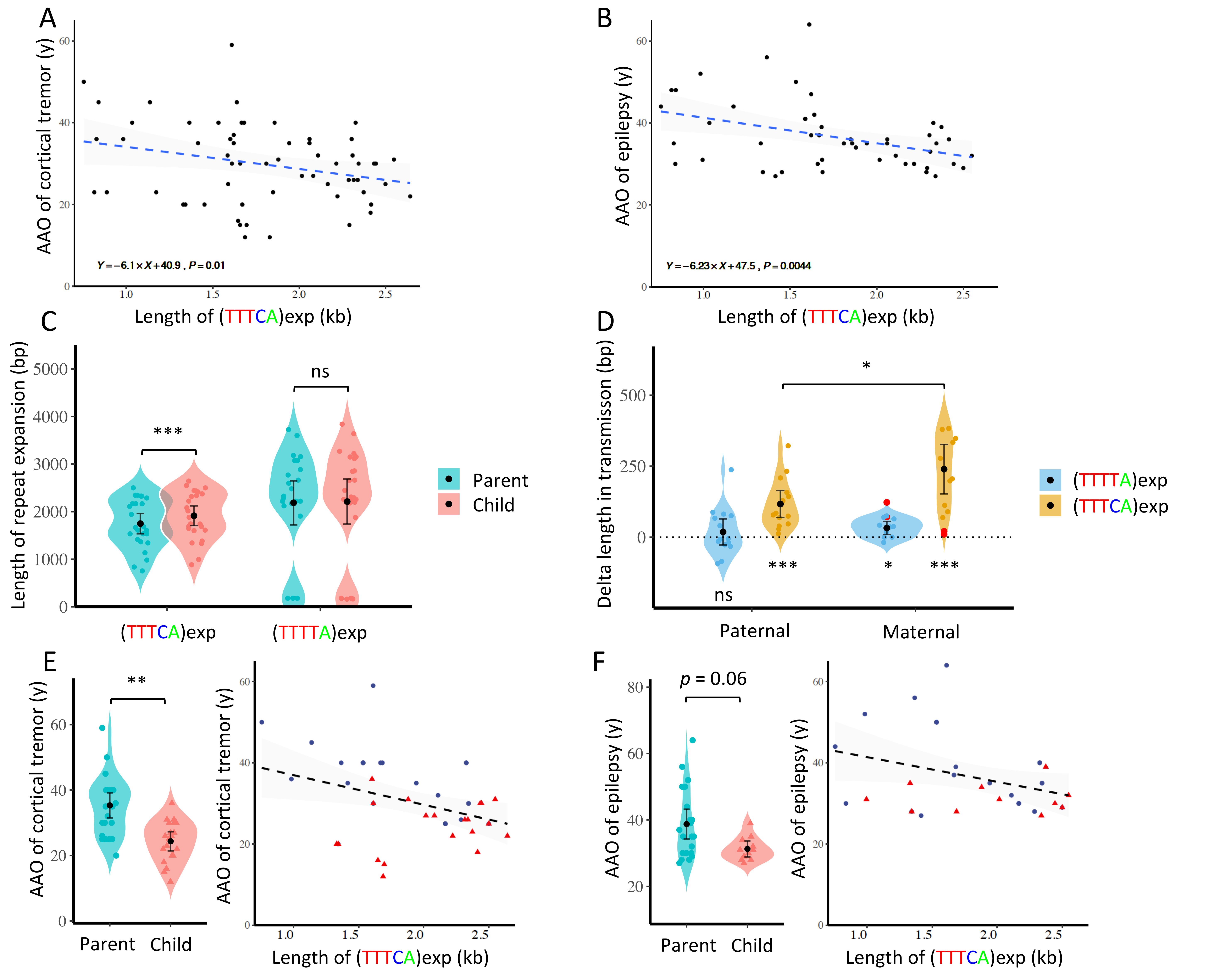Category: Myoclonus
Objective: To delineate and analyze the relationship between genetic and clinical features in 78 patients from 23 familial cortical myoclonic tremor with epilepsy type 1 (FCMTE1) pedigrees.
Background: FCMTE1 is a repeat expansion diseases (REDs) caused by a two-motif repeat expansion consisting of (TTTTA)exp (exp, expansion) and (TTTCA)exp, in SAMD12. Repeat instability between generations is tightly associated with the clinical phenotypes such as disease severity and age at onset (AAO). Therefore, the relationship between genetic and clinical features in FCMTE1 requires further study.
Method: Detailed AAO of cortical tremor and epilepsy of FCMTE1 patients were obtained. Targeted long-read sequencing was performed to confirm the accurate length of the (TTTCA)exp and (TTTTA)exp. Pearson’s Correlation was used to analyze the relationship between AAO and length of expansion. Paired samples t-test was used to analyze the intergenerational repeat instability.
Results: In our patients with FCMTE1, only the (TTTCA)exp length in (TTTTA)exp(TTTCA)exp was significantly negatively correlated with AAO for both cortical tremor (r = −0.322, p = 0.010, n = 62) and epilepsy (r = −0.400, p = 0.0044, n = 49) [Figure 1A, B], while the (TTTTA)exp length did not. Further analysis of 25 parent–offspring pairs showed that the (TTTCA)exp length of these transmissions significantly increased by 166 ± 116 bp (p = 2.3e−07), whereas the (TTTTA)exp length was relatively stable between generations (p = 0.08313) [Figure 1C]. The increase in the (TTTCA)exp length was significantly larger in maternal transmission than that in paternal transmission (p = 0.01436) [Figure 1D]. The AAO of cortical tremor was significantly earlier in the offspring (p = 0.004379). And the correlation between the AAO and the length of (TTTCA)exp remained significant [Figure 1E, F].
Conclusion: Our study is the largest cohort of FCMTE1 patients ever reported. The genotype-phenotype correlations confirmed the pathogenic role of (TTTCA)exp and non-pathogenicity of (TTTTA)exp. And according to the consistency between AAO and the intergenerational repeat instability in (TTTCA)exp, we further proposed that the (TTTCA)exp might be the major cause of the genetic anticipation.
References: 1. Cen Z, Jiang Z, Chen Y, et al. Intronic pentanucleotide TTTCA repeat insertion in the SAMD12 gene causes familial cortical myoclonic tremor with epilepsy type 1. Brain. 2018;141(8):2280-2288. 2. Khristich AN, Mirkin SM. On the wrong DNA track: Molecular mechanisms of repeat-mediated genome instability. J Biol Chem. 2020;295(13):4134-4170. 3. Hitomi T, Kondo T, Kobayashi K, Matsumoto R, Takahashi R, Ikeda A. Clinical anticipation in Japanese families of benign adult familial myoclonus epilepsy. Epilepsia. 2012;53(2):e33-e36.
To cite this abstract in AMA style:
ZD. Cen, XH. Chen, HT. Wang, DH. Yang, F. Zhang, Y. Chen, S. Chen, LB. Wang, P. Liu, F. Xie, B. Wang. Intergenerational repeat instability of TTTCA expansions in SAMD12 might be the major cause of the genetic anticipation in familial cortical myoclonic tremor with epilepsy [abstract]. Mov Disord. 2021; 36 (suppl 1). https://www.mdsabstracts.org/abstract/intergenerational-repeat-instability-of-tttca-expansions-in-samd12-might-be-the-major-cause-of-the-genetic-anticipation-in-familial-cortical-myoclonic-tremor-with-epilepsy/. Accessed December 24, 2025.« Back to MDS Virtual Congress 2021
MDS Abstracts - https://www.mdsabstracts.org/abstract/intergenerational-repeat-instability-of-tttca-expansions-in-samd12-might-be-the-major-cause-of-the-genetic-anticipation-in-familial-cortical-myoclonic-tremor-with-epilepsy/

